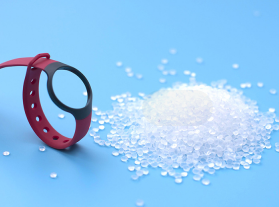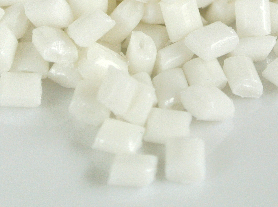PP resin polypropylene is thermoplastic polymers, meaning they may be formed with heat and re-melted without losing their intrinsic characteristics. Thermoplastics differ in this way from thermosets, which undergo permanent change after hardening. Thermoplastics are generally recyclable for this reason. Other thermoplastics include polyethylene, polyvinyl chloride, polystyrene, polycarbonate, acrylic, acrylonitrile butadiene styrene, nylon, and polytetrafluoroethylene. Information about these thermoplastics and other thermosets may be found in our Types of Resins guide.
| |
Properties
PP resin polypropylene is usually opaque, low-density polymers with excellent thermoforming and injection molding characteristics. Compared with other polymers, the material has a relatively narrow temperature range, becoming brittle below -20°C and unusable in temperatures beyond 120°C. It competes primarily against polyethylene and can be made transparent for items such as see-through packages, while polyethylene can only be made translucent, as in milk jugs, for example. Polypropylene cannot match the optical clarity of polymers such as polycarbonate but it does quite well.
| |
 Polypropylene homopolymers and polypropylene copolymers make up the majority of polypropylene formulations today. The homopolymer is the general-use grade, consisting of a single propylene monomer, and is semi-crystalline in form. A variety of copolymers are available, which, when compared to the homopolymer, have increased softness, better impact resistance, better durability and toughness, improved low-temperature strength, and better crack resistance. The general-use grade is the one recommended for food contact and applications where stiffness is important. Certain blends of co- and homopolymers result in materials that have high impact strength (PP impact copolymer); or, blended with ethylene and butane, superior film-sealing properties (PP terpolymer); or improved mechanical properties such as melt strength and extensibility (PP HMS). Polypropylene is available as an expanded, low-density, closed-cell foam (EPP). Polypropylene homopolymers and polypropylene copolymers make up the majority of polypropylene formulations today. The homopolymer is the general-use grade, consisting of a single propylene monomer, and is semi-crystalline in form. A variety of copolymers are available, which, when compared to the homopolymer, have increased softness, better impact resistance, better durability and toughness, improved low-temperature strength, and better crack resistance. The general-use grade is the one recommended for food contact and applications where stiffness is important. Certain blends of co- and homopolymers result in materials that have high impact strength (PP impact copolymer); or, blended with ethylene and butane, superior film-sealing properties (PP terpolymer); or improved mechanical properties such as melt strength and extensibility (PP HMS). Polypropylene is available as an expanded, low-density, closed-cell foam (EPP).
PP resin polypropylene’s low annealing temperature makes it difficult to machine and little has been done to produce filaments that are suited to 3D printing. However, its low viscosity at melt temperatures makes it well suited to extrusion and molding applications, including blow molding, compression molding, and roto molding, for example.
Unlike many thermoplastics, polypropylene does not readily absorb moisture, and under normal circumstances can usually be molded without being first subjected to a drying cycle. | |
| |
Applications Because of its low cost, polypropylene is popular for disposable food packaging. It is available in both flexible and semi-rigid films. Its decent puncture resistance and ability to guard against air and moisture transmission make it a good choice for protecting food. The film is available in two primary variants, cast (CPP) and biaxially oriented (BOPP), the latter being popular for its increased tensile strength over that of cast film.
| |
 Polypropylene also has a large footprint in the polymer fibers world where it is used for twine and ropes of many kinds, including those for marine applications due to its strength and moisture tolerance. It is also used to produce fabrics, tapes, webbing, carpeting, etc. Polypropylene thermal underwear has long been popular among skiers and other winter weather enthusiasts. Polypropylene also has a large footprint in the polymer fibers world where it is used for twine and ropes of many kinds, including those for marine applications due to its strength and moisture tolerance. It is also used to produce fabrics, tapes, webbing, carpeting, etc. Polypropylene thermal underwear has long been popular among skiers and other winter weather enthusiasts.
A common medical use of the material is for disposable syringes. In its medical-grade form, it can be steam-sterilized, opening its application to many reusable items including Petri dishes, vials, etc. The material has high chemical resistance but relatively poor resistance to bacteria and microbes.
Polypropylene has extensive use in automotive interior and exterior applications such as dashboards, passenger compartment trims, and wheel-well liners.
One somewhat specialized use of polypropylene is in the formation of so-called living hinges—as in the caps found on condiment bottles. These hinges, while incapable of load-bearing, are able to function through many, many cycles before failing, owing to the material’s high flexural strength and fatigue resistance.
| |
Costs
Along with polyethylene, polypropylene is among the lowest costs of thermoplastic resins. Costs rise, of course, as the selection moves away from the general-purpose grade to some of the more specialized varieties. Polypropylene may be purchased in pellet form for molding and extruding, both as new and as regrind. It is available in both flexible and semi-rigid film for packaging, in sheet-form for thermoforming, in various extruded shapes such as rounds and bars, and as expanded foam.









 Polypropylene homopolymers and polypropylene copolymers make up the majority of polypropylene formulations today. The homopolymer is the general-use grade, consisting of a single propylene monomer, and is semi-crystalline in form. A variety of copolymers are available, which, when compared to the homopolymer, have increased softness, better impact resistance, better durability and toughness, improved low-temperature strength, and better crack resistance. The general-use grade is the one recommended for food contact and applications where stiffness is important. Certain blends of co- and homopolymers result in materials that have high impact strength (PP impact copolymer); or, blended with ethylene and butane, superior film-sealing properties (PP terpolymer); or improved mechanical properties such as melt strength and extensibility (PP HMS). Polypropylene is available as an expanded, low-density, closed-cell foam (EPP).
Polypropylene homopolymers and polypropylene copolymers make up the majority of polypropylene formulations today. The homopolymer is the general-use grade, consisting of a single propylene monomer, and is semi-crystalline in form. A variety of copolymers are available, which, when compared to the homopolymer, have increased softness, better impact resistance, better durability and toughness, improved low-temperature strength, and better crack resistance. The general-use grade is the one recommended for food contact and applications where stiffness is important. Certain blends of co- and homopolymers result in materials that have high impact strength (PP impact copolymer); or, blended with ethylene and butane, superior film-sealing properties (PP terpolymer); or improved mechanical properties such as melt strength and extensibility (PP HMS). Polypropylene is available as an expanded, low-density, closed-cell foam (EPP). Polypropylene also has a large footprint in the polymer fibers world where it is used for twine and ropes of many kinds, including those for marine applications due to its strength and moisture tolerance. It is also used to produce fabrics, tapes, webbing, carpeting, etc. Polypropylene thermal underwear has long been popular among skiers and other winter weather enthusiasts.
Polypropylene also has a large footprint in the polymer fibers world where it is used for twine and ropes of many kinds, including those for marine applications due to its strength and moisture tolerance. It is also used to produce fabrics, tapes, webbing, carpeting, etc. Polypropylene thermal underwear has long been popular among skiers and other winter weather enthusiasts.

